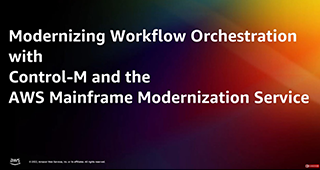In today’s complex and rapidly evolving digital landscape, organizations recognize business modernization as a key priority to drive growth and innovation. They are embracing a culture of agility and responsiveness that leverages both emerging technologies and tools and agile application and data pipeline development methods to foster customer-centric solutions.
One area of enterprise digital modernization currently getting a lot of attention is the mainframe. As part of their modernization efforts, mainframe organizations are evaluating migrating applications to newer platforms like cloud and containers.
However, while the lure of more agility and flexibility for mainframe applications is a strong incentive, companies face significant risks because these changes can potentially impact critical business services. They’re also seeking to capitalize on these new technology investments while still preserving the knowledge and expertise embedded within existing applications, processes, and workflows that deliver these business-critical outcomes.
Consequently, most organizations with mainframe pursue a strategic migration approach that balances the pace of transition while still retaining the existing components that continue to deliver value and selectively migrating others that are better served by modern environments.
To manage this balancing act, mitigate operational risks, and execute a smooth journey to the desired state, companies rely on two core technology platforms—Control-M, BMC’s application and data workflow orchestration platform, and Micro Focus Enterprise Server, Open Text’s solution for mainframe application replatforming.
Migrating application and data workflows
While mainframe systems are well-known for powering real-time transactions, the majority of their workloads actually run as batch. These batch jobs are integrated into workflows to deliver essential business outcomes such as supply chain execution, customer billing, payments, and end-of-period closing. Over time, the workflows have evolved, often becoming hybrid and complex in nature as they incorporate modern infrastructure and data technologies. While evolving, they have also been adapted to company processes and standards, accumulating best practices, insights, and institutional knowledge.
Migrating these critical workflows of tightly interconnected applications and data sources, and maintaining the associated institutional knowledge, is a key challenge in almost every mainframe application migration. Control-M is an ideal platform in this context. It ensures the integration of mainframe and migrated applications alongside other technologies on distributed systems, cloud, and container platforms. It also preserves built-in knowledge, processes, and standards, and enables a smooth, no-risk migration at the speed the organization desires.
In addition, Micro Focus Enterprise Server is a high-performance, scalable deployment environment that allows applications traditionally run on IBM® mainframes to be moved to other platforms (replatformed), including distributed systems, cloud, and containers, with only minor adjustments.
Managed transformation
Control-M has recently delivered a Micro Focus Enterprise Server integration that enables the centralized orchestration of Micro Focus jobs alongside other application and data workflows. This integration supports managing Micro Focus jobs through Control-M’s interfaces, leveraging the same advanced orchestration capabilities used across mainframe jobs, file transfers, enterprise resource planning (ERP) solutions, data sources, and cloud and container services.
Control-M’s integration with Micro Focus Enterprise Server, coupled with BMC’s migration tools and support team expertise, positions the combined solution as the go-to migration resource and capability for mainframe modernization projects.
Control-M can easily replace mainframe applications with replatformed Micro Focus jobs, maintaining dependencies, workflow structure, built-in knowledge, and adherence to processes and standards. The change is operationally transparent, as Control-M continues to provide holistic visibility and standardized management of application and data workflows across source and destination environments, delivering consistent business outcomes and value as applications and the landscape evolve.
For existing Control-M customers, replatforming from mainframe to distributed or on-premises servers and/or cloud environments is guided, simple, and secure. The BMC Services organization, including its global partner network, is available to assist customers in migrating mainframe workflows through complete or selective replacement with Micro Focus jobs, providing continuously updated migration tools and sharing their expertise in converting workflows between platforms.
The BMC Services team follows a proven methodology with four key phases:
- Planning: Includes creating a roadmap by assessing applications, dependencies, and environment constraints.
- Development: Migrates applications using migration tools to minimize errors.
- Verification: Compares original and migrated workflow outputs.
- Execution: Deploys workloads once validation is complete.
Proven success
One BMC customer achieving success with such a migration is AG Insurance. To maintain its market leadership, the company is focused on customer and competitive differentiation, adding products and experiences to make it the best choice for customers, distributors, and brokers. The organization has embarked on an ambitious and complex replatforming modernization project to migrate from its mainframe to Windows servers.
Control-M has been integral to this transformation. As part of the replatforming project, AG Insurance migrated more than 80 million lines of code through Micro Focus application modernization solutions. To minimize risk and facilitate planning and implementation, the migration was accomplished through several sequential iterations, each with its own testing and validation cycles. During the iterative application migration process, Control-M was essential to the testing of parallel workflows, including migrated and non-migrated applications across the mainframe and the new distributed platform, and verifying that the business results they produced were identical.
Control-M continues to be the strategic orchestration framework driving all of AG Insurance’s applications and data workflows and enabling new possibilities.
Contemplating mainframe migration?
If you are one of the many mainframe-driven enterprises contemplating or actively pursuing a modernization program, Control‑M and Micro Focus Enterprise Server offer a compelling, integrated capability to manage your journey. Together, the solutions can help you adapt workflows and services with operational transparency so your organization can achieve a seamless transition from the mainframe while preserving your vital institutional knowledge and experience.
The migration can be approached through a managed methodology that leverages both Control-M’s expertise in migrating mainframe application workflows and Micro Focus’ expertise in migrating mainframe applications to mitigate risks and allow customers to migrate at their own pace.
For more information on how Control-M and Micro Focus Enterprise Server can advance your mainframe modernization initiative, download this whitepaper.







